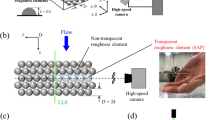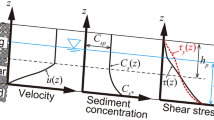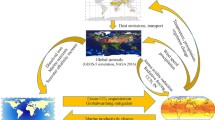Abstract
Measurements of electric currents of saltation in the wind-sand flux and currents caused by the wind transport of dust aerosol particles have been carried out in the desertified territories of Astrakhan oblast and Kalmykia. Empirical distribution functions of the specific charge of saltating particles in a wind-sand flux are presented for the conditions of quasi-continuous and intermittent saltation. It is established that the electric charge surface density reaches +25 nC/m2. It is shown that the local electric field on the surface of the saltating particles can exceed 450 kV/m. An abnormal high electrization mechanism of the wind-sand flux is proposed, including the initiation of high-speed saltation: electric (corona) discharges on the underlying surface, which makes it possible to consider the wind-sand flux a dusty plasma. An analytical model has been developed for the escape of saltating particles from the underlying surface during a corona discharge. It is shown that, when saltation is initiated by a corona discharge, the escape velocity of charged particles can exceed 1 m/s.






Similar content being viewed by others
REFERENCES
IPCC Special Report on Global Warming of 1.5°C, 2018.
A. N. Zolotokrylin, Climatic Desertification (Nauka, Moscow, 2003 [in Russian].
R. A. Bagnold, The Physics of Blown Sand and Desert Dunes (Methuen, London, 1941).
Y. Shao, Physics and Modeling of Wind Erosion (Springer, New York, 2000).
X. Y. Zheng, Mechanics of Windblown Sand Movements (Springer, Berlin, 2009).
O. E. Semenov, Introduction to the Experimental Meteorology and Climatology of Sandstorms (KazNIIEK, Almaty, 2011) [in Russian].
J. F. Kok, E. J. R. Parteli, T. I. Michaels, and D. B. Karam, “The physics of wind-blown sand and dust,” Rep. Prog. Phys. 75, 1–119 (2012).
N. Mahowald, S. Albani, J. F. Kok, S. Engelstaeder, R. Scanza, D. S. Ward, and M. G. Flanner, “The size distribution of desert dust aerosols and its impact on the Earth system,” Aeolian Res. 15, 53–71 (2014).
R. Miller, I. Tegen, and J. Perlwitz, “Surface radiative forcing by soil dust aerosol and the hydrologic cycle,” J. Geophys. Res. 109, DO4203 (2004).
B. A. Mather, J. M. Prospero, D. Mackie, D. Gaiero, P. P. Hesse, and Y. Balkanski, “Global connections between aeolian dust, climate and ocean biogeochemistry at the present day and at the last glacial maximum,” Earth Sci. Rev. 99, 61–97 (2010).
B. Brunekreef and S. T. Holgate, “Air pollution and health,” Lancet 360, 1233–1242 (2002).
E. K. Byutner, Dynamics of the Near-Surface Air Layer (Gidrometeoizdat, Leningrad, 1978) [in Russian].
G. I. Gorchakov, D. V. Buntov, A. V. Karpov, V. M. Kopeikin, S. F. Mirsaitov, R. A. Gushchin, and O. I. Datsenko, “The saltating particle aleurite mode in wind–sand flux over a desertified area,” Dokl. Earth Sci. 488 (2), 1103–1106 (2019).
F. G. Pettijohn, Sedimentary Rocks (Harper, New York, 1957).
G. I. Gorchakov, D. V. Buntov, A. V. Karpov, V. M. Kopeikin, S. F. Mirsaitov, R. A. Gushchin, and O. I. Datsenko, “Wind effect on the size distribution of saltating particles,” Atmos. Oceanic Opt. 33 (2), 198–205 (2020).
A. V. Karpov, G. I. Gorchakov, R. A. Gushchin, and O. I. Datsenko, “Aleurite particle saltation modeling,” Proc. SPIE: Int. Soc. Opt. Eng. 11208, 112084 (2020).
G. I. Gorchakov, A. V. Karpov, R. A. Gushchin, O. I. Datsenko, and D. V. Buntov, “Vertical profiles of the saltating particle concentration on a desertified area,” Dokl. Earth Sci. 496 (2), 119–124 (2021).
G. I. Gorchakov, A. V. Karpov, R. A. Gushchin, O. I. Datsenko, and D. V. Buntov, “Vertical distribution of aleurite and sand particles in windsand flux over a desertified area,” Izv., Atmos. Ocean. Phys. 57 (5), 486–494 (2021).
A. M. Obukhov, Turbulence and Dynamics of the Atmosphere (Gidrometeoizdat, Leningrad, 1988) [in Russian].
S. L. Namikas, “Field measurement and numerical modelling of aeolian mass flux distributions on a sandy beach,” Sedimentology 50, 303–326 (2003).
K. R. Rasmussen and M. Sorensen, “Vertical variation of particle speed and flux in aeolian saltation: Measurement and modeling,” J. Geophys. Res. 113, FO2S12 (2008).
T. D. Ho, P. Dupont, A. O. E. Moctar, and A. Valance, “Particle velocity distribution in saltation transport,” Phys. Rev. E 85 (5), 052301 (2012).
D. S. Schmidt, R. A. Schmidt, and Y. D. Dent, “Electrostatic force on saltating sand,” J. Geophys. Res. 103 (D8), 8997–9001 (1998).
S. V. Anisimov, E. A. Mareev, N. M. Shikhova, and E. M. Dmitriev, “Mechanisms for the formation of electric-field pulsation spectra in the near-surface atmosphere,” Radiophys. Quantum Electron. 44 (7), 562–579 (2001).
V. A. Donchenko, M. V. Kabanov, B. V. Kaul’, P. M. Nagorskii, and I. V. Samokhvalov, Electrooptical Phenomena in the Atmosphere (NTL, Tomsk, 2015) [in Russian].
G. I. Gorchakov, V. I. Ermakov, V. M. Kopeikin, A. A. Isakov, A. V. Karpov, and A. V. Ul’yanenko, “Electric currents of saltation in windsand flux,” Dokl. Earth Sci. 410 (2), 1109–1111 (2006).
G. I. Gorchakov, V. M. Kopeikin, A. V. Karpov, A. A. Titov, D. V. Buntov, G. A. Kuznetsov, R. A. Gushchin, O. I. Dazenko, G. A. Kurbatov, A. O. Seregin, and A. V. Sokolov, “Variations in the specific charge of saltating sand in a windsand flux over a desertified area,” Atmos. Oceanic Opt. 29 (1), 244–251 (2016).
G. I. Gorchakov, V. M. Kopeikin, A. V. Karpov, D. V. Buntov, and A. V. Sokolov, “The specific charge of saltation sand particles in arid territories,” Dokl. Earth Sci. 456 (4), 700–704 (2014).
G. I. Gorchakov, A. V. Karpov, V. M. Kopeikin, D. V. Buntov, R. A. Gushchin, and O. I. Datsenko, “Dust aerosol emission on the desertified area,” Proc. SPIE: Int. Soc. Opt. Eng. 11560, 1156076 (2020).
T. L. Bo and X. J. Zheng, “A field observational study of electrification within a dust storm in Minqin, China,” Aeolian Res. 8, 39–47 (2013).
P. C. Sinclair, “General characteristics of dust devils,” J. Appl. Meteorol. Climatol. 8 (1), 32–45 (1969).
V. A. Saranin, “Electric field strength of charged conducting balls and the breakdown of the air gap between them,” Phys.-Usp. 45 (12), 1287–1292 (2002).
S. C. Alfaro, A. Gaudichet, L. Gomes, and M. Maille, “Modeling the size distribution of a soil aerosol produced by sandblasting,” J. Geophys. Res. 102, 11239–11249 (1997).
G. I. Gorchakov, A. V. Karpov, and R. A. Gushchin, “Turbulent fluxes of the dust aerosol on the desertified area,” Dokl. Earth. Sci. 494 (2), 799–802 (2020).
A. V. Karpov, G. I. Gorchakov, R. A. Gushchin, and O. I. Datsenko, “Vertical turbulent dust-aerosol fluxes,” Izv., Atmos. Ocean. Phys. 57 (5), 495–503 (2021).
J. F. Kok and N. O. Renno, “Electrostatics in wind-blown sand,” Phys. Rev. Lett. 100 (1), 01450L (2008).
G. I. Gorchakov, A. V. Karpov, V. M. Kopeikin, A. V. Sokolov, and D. V. Buntov, “Influence of the Saffman force, lift force, and electric force on sand grain transport in a wind–sand flow,” Dokl. Earth Sci. 467 (3), 314–319 (2016).
F. Esposito, R. Molinaro, C. I. Popa, C. Molfese, F. Cozzolino, L. Marty, K. Taj-Eddine, G. Di Achille, G. Franzese, S. Silvestro, and G. G. Ori, “The role of the atmospheric electric field in the dust-lifting process,” Geophys. Res. Lett. 43 (10), 5501–5508 (2016).
E. A. Malinovskaya, O. G. Chkhetiani, I. N. Panchishkina, G. G. Petrova, and A. I. Petrov, “The relationship between a surface electric field and an arid aerosol under different wind conditions,” Dokl. Earth Sci. 502 (2), 59–67 (2022).
V. E. Fortov, A. G. Khrapak, S. A. Khrapak, V. I. Molotkov, and O. F. Petrov, “Dusty plasmas,” Phys.-Usp. 47 (5), 447–492 (2004).
V. E. Fortov, A. G. Khrapak, and I. T. Yakubov, Nonideal Plasma Physics (Fizmatiz, Moscow, 2010 [in Russian].
V. V. Smirnov, Ionization in the Troposphere (Gidrometeoizdat, St. Petersburg, 1992) [in Russian].
D. V. Sivukhin, Electricity: General Course of Physics (Nauka, FML, Moscow, 1983) [in Russian].
Yu. K. Stishkov, A. V. Samusenko, and I. A. Ashikhmin, “Corona discharge and electrogasdynamic flows in the air,” Phys.-Usp. 61 (12), 1213–1226 (2018).
L. V. Kashleva, Atmospheric Electricity (RGGU, St. Petersburg, 2008) [in Russian].
A. A. Sin’kevich and Yu. A. Dovgalyuk, “Corona discharge in clouds,” Radiophys. Quantum Electron. 56 (11–12), 818–828 (2014).
E. Kamke, Differentialgleichungen: Lösungsmethoden und Lösungen (Geest und Portig K.-G., Leipzig, 1959; Nauka, Fizmatiz, 1961).
J. F. Kok and D. J. Lacks, “Electrification of granular systems of identical insulators,” Phys. Rev. E 79 (5), 051304 (2009).
ACKNOWLEDGMENTS
The authors thank G.S. Golitsyn for helpful advice and O.G. Chkhetiani for participating in discussions of the results.
Funding
This work was supported by the Russian Science Foundation (grant no. 20-17-00214).
Author information
Authors and Affiliations
Corresponding author
Ethics declarations
The authors declare that they have no conflicts of interest.
Additional information
Translated by V. Selikhanovich
Rights and permissions
About this article
Cite this article
Gorchakov, G.I., Kopeikin, V.M., Karpov, A.V. et al. Dusty Plasma of a Wind-Sand Flux in Desertified Areas. Izv. Atmos. Ocean. Phys. 58, 466–475 (2022). https://doi.org/10.1134/S000143382205005X
Received:
Revised:
Accepted:
Published:
Issue Date:
DOI: https://doi.org/10.1134/S000143382205005X
Keywords:
- desertification
- electrization of a wind-sand flux
- electric saltation currents
- electric currents caused by wind transfer of dust aerosol particles
- electric currents
- density of electric charges on the underlying surface
- local electric field strength
- specific charge
- corona discharge
- dusty plasma of a wind-sand flux
- initiation of saltation by corona discharges
- saltating particle escape velocity




